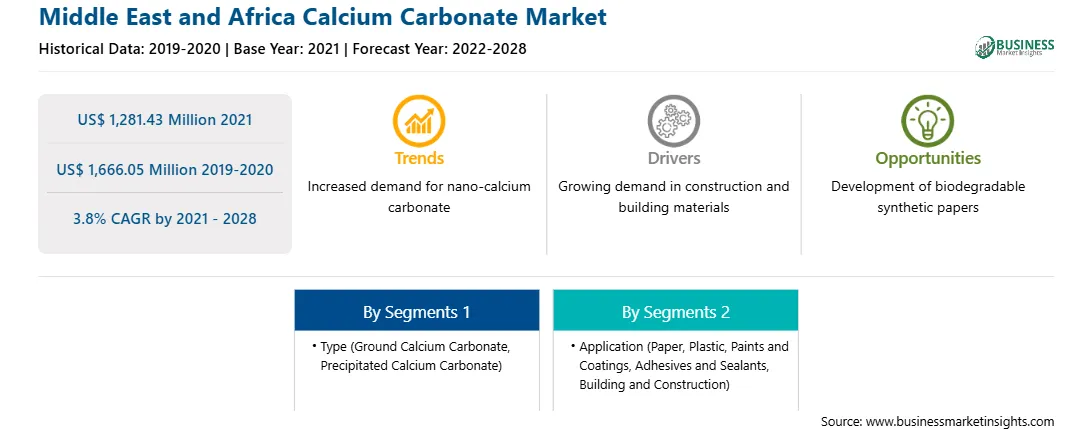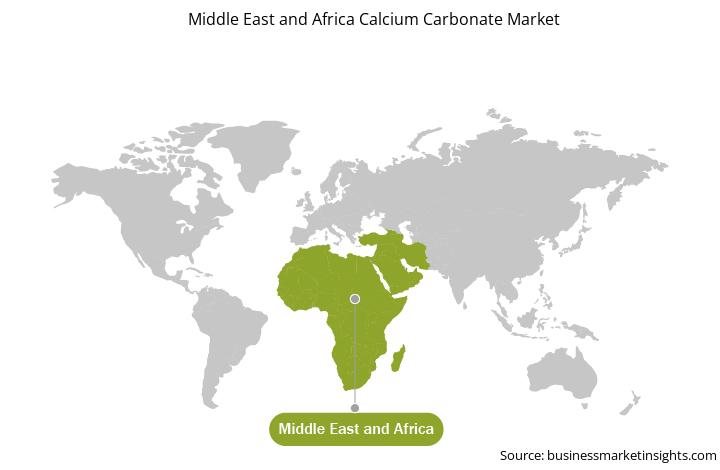The Middle East region is well known for oil production and export, which has a considerable impact on the entire region in terms of money and labor use. The Middle East's oil and gas industry is one of the world's largest and most valuable (in terms of GDP). Indeed, the Middle East produces a third (27%) of the world's oil, with Saudi Arabia, Iraq, and the United Arab Emirates topping the list of the world's top oil producers. Saudi Arabia alone accounts for approximately 15 percent of global output. The production of oil & gas in Middle East region derive the demand for calcium carbonate. In the oil and gas business, calcium carbonate scale is very frequent. It is frequently induced by a temperature change or a pressure decrease, and it can result in considerable production constraints and formation damage. In the oil and gas industry, calcium carbonate is used as a formation-bridging agent, and it is added to drilling mud to improve the density of the mud in oilfield drilling applications. It increases the mud's density to roughly 1.44 kg per cubic metre, or 12 pounds per gallon. This chemical compound can be used to clean up production zones because it dissolves easily in hydrochloric acid. Calcium carbonate, when combined with polymers, can help to reduce fluid loss in brines. Rising demand for innovative products and burgeoning applications of calcium carbonate are the major factor driving the growth of the MEA calcium carbonate market.
In case of COVID-19, MEA is highly affected especially Saudi Arabia which has reported the highest number of COVID-19 cases in the MEA, followed by Turkey and the UAE. Chemicals & materials is one of the key industries experiencing severe disruptions due to disruptions in supply chain and shutdown of manufacturing and assembly plants in MEA region; this has hampered the global value chain, manufacturing processes, distribution schedules, and product sales. As a result, several firms have already announced possible delays in product delivery and projected a reduction in future product revenues. Lockdowns imposed by governments in the Middle East and African countries have led to the discontinuation of numerous chemicals & materials plants and construction activities in the region. This has further lowered the demand for calcium carbonate. However, construction, paint and coatings and many other industries have started to recover with the start of manufacturing and production activities again. So, the demand for calcium carbonate will increase as the market fundamentals will get return to normalcy.

Strategic insights for the Middle East and Africa Calcium Carbonate provides data-driven analysis of the industry landscape, including current trends, key players, and regional nuances. These insights offer actionable recommendations, enabling readers to differentiate themselves from competitors by identifying untapped segments or developing unique value propositions. Leveraging data analytics, these insights help industry players anticipate the market shifts, whether investors, manufacturers, or other stakeholders. A future-oriented perspective is essential, helping stakeholders anticipate market shifts and position themselves for long-term success in this dynamic region. Ultimately, effective strategic insights empower readers to make informed decisions that drive profitability and achieve their business objectives within the market.

| Report Attribute | Details |
|---|---|
| Market size in 2021 | US$ 1,281.43 Million |
| Market Size by 2028 | US$ 1,666.05 Million |
| Global CAGR (2021 - 2028) | 3.8% |
| Historical Data | 2019-2020 |
| Forecast period | 2022-2028 |
| Segments Covered |
By Type
|
| Regions and Countries Covered | Middle East and Africa
|
| Market leaders and key company profiles |
The geographic scope of the Middle East and Africa Calcium Carbonate refers to the specific areas in which a business operates and competes. Understanding local distinctions, such as diverse consumer preferences (e.g., demand for specific plug types or battery backup durations), varying economic conditions, and regulatory environments, is crucial for tailoring strategies to specific markets. Businesses can expand their reach by identifying underserved areas or adapting their offerings to meet local demands. A clear market focus allows for more effective resource allocation, targeted marketing campaigns, and better positioning against local competitors, ultimately driving growth in those targeted areas.

The MEA calcium carbonate market is expected to grow from US$ 1,281.43 million in 2021 to US$ 1,666.05 million by 2028; it is estimated to grow at a CAGR of 3.8% from 2021 to 2028. Surging requirement on the back of thriving paints and coatings industry is expected to escalate the MEA calcium carbonate market. Paints and coatings are mainly used in construction projects for protection and decoration. These are also used in interior and exterior house paints, primers, sealers, and varnishes. Construction activities are increasing due to supportive government initiatives. Manufacturers in the paint and coating market are continuously introducing new, high-performance, and environment-friendly products. Calcium carbonate has a special white color that makes it a preferred pigment option in coating applications. It provides improved paint sheen, opacity, and wear resistance, among others. It is appropriate for the uppermost coats due to high gloss retention. Therefore, calcium carbonate is extensively being used in the paint and coating industry. Automotive industry is another segment generating high demand for paint and coating products, thereby fueling the MEA calcium carbonate market growth.
In terms of type, the ground calcium carbonate (GCC) segment accounted for the largest share of the MEA calcium carbonate market in 2020. In terms of application, the paper segment held a larger market share of the MEA calcium carbonate market in 2020.
A few major primary and secondary sources referred to for preparing this report on the MEA calcium carbonate market are company websites, annual reports, financial reports, national government documents, and statistical database, among others. Major companies listed in the report are Imerys S.A., J.M. Huber Corporation, LafargeHolcim, Minerals Technologies Inc., and Omya AG
The Middle East and Africa Calcium Carbonate Market is valued at US$ 1,281.43 Million in 2021, it is projected to reach US$ 1,666.05 Million by 2028.
As per our report Middle East and Africa Calcium Carbonate Market, the market size is valued at US$ 1,281.43 Million in 2021, projecting it to reach US$ 1,666.05 Million by 2028. This translates to a CAGR of approximately 3.8% during the forecast period.
The Middle East and Africa Calcium Carbonate Market report typically cover these key segments-
The historic period, base year, and forecast period can vary slightly depending on the specific market research report. However, for the Middle East and Africa Calcium Carbonate Market report:
The Middle East and Africa Calcium Carbonate Market is populated by several key players, each contributing to its growth and innovation. Some of the major players include:
The Middle East and Africa Calcium Carbonate Market report is valuable for diverse stakeholders, including:
Essentially, anyone involved in or considering involvement in the Middle East and Africa Calcium Carbonate Market value chain can benefit from the information contained in a comprehensive market report.